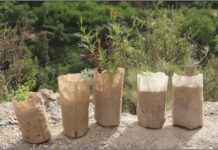In 2022, there is a push towards conscious consumerism, which is certainly positive. There is increasing pressure on brands to put the environment first; studies show that, particularly post Covid-19, consumers want manufacturers to have an ethical value-chain. More consumers are becoming aware of the impact that they – and the brands they support – have on the environment.
From reduced emissions to sustainable packaging, the conscious consumer rates climate change as one of two top issues on which they expect brands to act. Despite this, landfills, which release greenhouse gas into the atmosphere, are reaching capacity and it’s estimated that 99 percent of plastic packaging is made from chemicals sourced from fossil fuels.
In addressing the environmental challenges of waste management, the three Rs – reduce, reuse, recycle – has been reiterated again and again. Yet, global use of finite, raw materials has tripled in the past 50 years, and it’s predicted to double again by 2050. Even with reducing, reusing, and recycling, this can’t be sustained.
So, for consumerism to be truly conscious – and packaging to be truly sustainable – it may be time to add two more Rs: renewability and respect for the environment.
‘Reduce, reuse, and recycle’ is still important
To keep waste out of landfills, implementing the three Rs of waste management is still crucial, however, on both a large-scale and individual level.
Reducing means creating less waste from the start, and anyone can do this. For example, avoiding individually packaged items, or those in single-use packaging.
Reusing entails finding new ways to use items that would ordinarily end up in a landfill, such as using old glass jars to store spices.
Recycling transforms waste into something that serves a new purpose.
At Nampak Liquid Cartons, we are a strong proponent of all the above, but recycling is particularly important. Not only does recycling spur job creation – it’s estimated that 62 000 people in South Africa collect recyclables in the informal economy alone – but it also has a significant impact on the environment. In fact, waste reclaimers collect up to 90 percent of all post-consumer packaging.
From an industry perspective, organisations like Fibre Circle, the producer responsibility organisation (PRO) for the paper and paper packaging sector, play a vital role in the enabling the three Rs, too. Ultimately, partnerships between producers and PROs aim to get the entire packaging value-chain’s products out of landfills.
The circular economy and renewability
But, according to The World Economic Forum, only nine percent of extracted materials are reused, and 62 percent of global greenhouse gases are emitted during the extraction, processing, and production of goods. Reusing, reducing, and recycling isn’t quite cutting it in terms of making a significant difference in preserving our planet.
This is where the circular economy and renewability come in. A circular economy departs from the ‘take-make-waste’ model, where everything ends up in a landfill. It’s also different to a recycling model, where recyclable material goes to recycling mills. In a circular economy, the ideal of ‘zero waste’ can become a reality, as the full life cycle of product – before and after consumption – is taken into consideration. Renewable resources, like wood, support a circular economy as these raw materials can be regenerated, unlike fossil fuels.
For example, Nampak Liquid Cartons are made from a renewable resource, wood, that comes from responsibly managed forests. This means trees are planted specifically to supply wood for the paperboard and then new trees are planted in their place. In addition, these trees serve as ‘carbon sinks’, storing carbon out of the atmosphere and helping to mitigate global warming.
Education and respect for the environment
UNESCO wants to make environmental education a core part of schools’ curricula by 2025, and the relationship between education and the environment can’t be over-emphasised. But we’re still not doing enough: in 2020, the paper recovery rate was almost 70 percent, yet food and beverage cartons only made up a fraction of this.
Why is this the case? It comes down to education. Many South African consumers don’t realise that by making a simple choice when it comes to packaging, they can help reduce their environmental impact. According to the Paper Manufactures’ Association of South Africa, we recycle 1.2 million tonnes of paper per year, which is essentially about 200 soccer pitches’ worth of paper. If we added more liquid paperboard cartons to the mix, the difference would be staggering. This is why at Nampak Liquid Cartons, it’s critical that we raise awareness of the sustainable value of cartons.
As Audrey Azoulay, UNESCO’s Director-General says, “Education must prepare learners to understand the current crisis and shape the future.” This can be applied to the context of the packaging industry and consumers. To make the three Rs work, we must foster a drive towards another two – renewability and respect for our environment. This will inevitably shape a more sustainable future.









